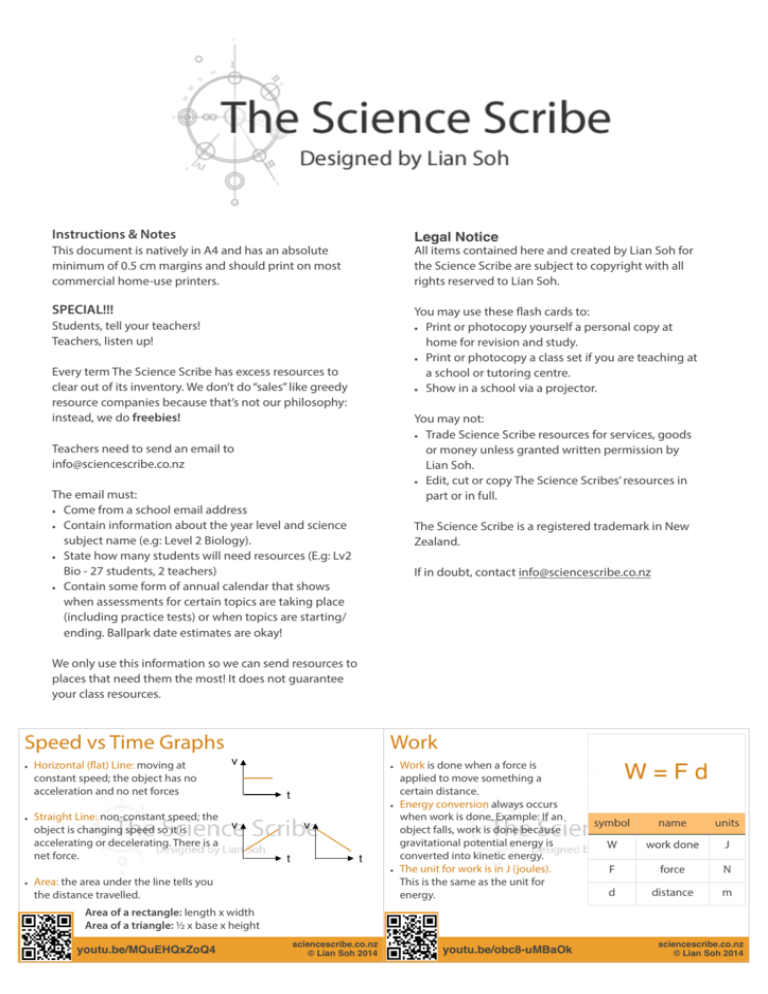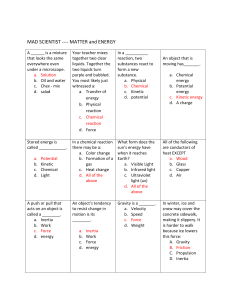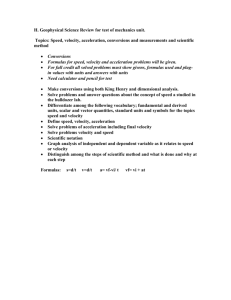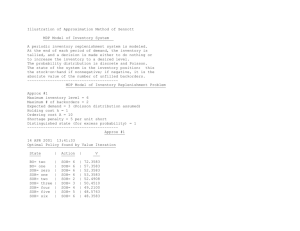
!
!
!
!
!
!
!
!
!
!
!
!
!
! Instructions & Notes
!
!
!
! !
! SPECIAL!!!
!
!
! !
!
!
!
!
! !
!
!
! !
!
!
!
!
!
!
!
!
!
!
!
!
!
!
!
!
!Speed vs Time Graphs
!
!
!
!!
!
!
!
!
!!
!
!
!
!
!
!
Legal Notice!
This document is natively in A4 and has an absolute
minimum of 0.5 cm margins and should print on most
commercial home-use printers.
All items contained here and created by Lian Soh for
the Science Scribe are subject to copyright with all
rights reserved to Lian Soh.
!
You may use these flash cards to:
• Print or photocopy yourself a personal copy at
home for revision and study.
• Print or photocopy a class set if you are teaching at
a school or tutoring centre.
• Show in a school via a projector.
Students, tell your teachers!
Teachers, listen up!
Every term The Science Scribe has excess resources to
clear out of its inventory. We don’t do “sales” like greedy
resource companies because that’s not our philosophy:
instead, we do freebies!
!
You may not:
• Trade Science Scribe resources for services, goods
or money unless granted written permission by
Lian Soh.
• Edit, cut or copy The Science Scribes’ resources in
part or in full.
Teachers need to send an email to info@sciencescribe.co.nz
The email must:
• Come from a school email address
• Contain information about the year level and science
subject name (e.g: Level 2 Biology).
• State how many students will need resources (E.g: Lv2
Bio - 27 students, 2 teachers)
• Contain some form of annual calendar that shows
when assessments for certain topics are taking place
(including practice tests) or when topics are starting/
ending. Ballpark date estimates are okay!
!
The Science Scribe is a registered trademark in New
Zealand.
!
If in doubt, contact info@sciencescribe.co.nz
We only use this information so we can send resources to
places that need them the most! It does not guarantee
your class resources.
• Horizontal (flat) Line: moving at
constant speed; the object has no
acceleration and no net forces
• Straight Line: non-constant speed; the
object is changing speed so it is
accelerating or decelerating. There is a
net force.
Work
v
t
v
v
t
t
• Area: the area under the line tells you
the distance travelled.
• Work is done when a force is
applied to move something a
certain distance.
• Energy conversion always occurs
when work is done. Example: If an
object falls, work is done because
gravitational potential energy is
converted into kinetic energy.
• The unit for work is in J (joules).
This is the same as the unit for
energy.
Area of a rectangle: length x width
Area of a triangle: ½ x base x height
youtu.be/MQuEHQxZoQ4
sciencescribe.co.nz
© Lian Soh 2014
youtu.be/obc8-uMBaOk
sciencescribe.co.nz
© Lian Soh 2014
!
!Acceleration
!
!
!
Distance vs Time Graphs
• Acceleration is defined as a change in
velocity over a change in time.
• A change in velocity means that
something moves at non constant
speed.
• 𝝙 is read as “change in”
• The gradient (slope/steepness) of a
velocity vs time graph equals
acceleration. Note: the total area under
a velocity vs time graph equals the total
distance travelled.
youtu.be/TFaTPxtmT50
• Horizontal (flat) Line: stopped or
stationary, the object has no
acceleration and no net forces.
d
• Straight Line: constant velocity; the
object has no acceleration and no net
forces.
d
!
!
• Curved Line: non-constant velocity; the
object is changing speed which means d
it is accelerating/decelerating. There is
a net force.
sciencescribe.co.nz
© Lian Soh 2014
youtu.be/9keMUFKhcS0
Energy (kinetic)
Energy (grav. pot.)
• Kinetic Energy: is active energy. It is
the energy possessed by an object in
motion.
• Mass is directly proportional to the
kinetic energy. This means that
doubling the mass will double the
kinetic energy.
• Velocity is proportional to the kinetic
energy such that doubling the
velocity will quadruple the kinetic
energy.
• Lifting an object means work is done
to raise it. As it is raised it gains
gravitational potential energy.
• Potential energy is stored energy
because it has the ability to be
released to do work.
• Dropping an object will change most
of the stored gravitational potential
energy into kinetic energy. The rest is
changed into small amounts of heat
and sound caused by friction with air.
youtu.be/-LVnV_hui0U
t
sciencescribe.co.nz
© Lian Soh 2014
youtu.be/ORc9Y2fehPw
Forces
Power
• Forces can change an objects’
speed or direction.
• Net Force is an overall force. There is
a net force when all forces on an
object are unbalanced. If
something has a net force it will
accelerate or decelerate.
• Weight is the force caused by the
downward acceleration due to
gravity: 10 N kg-1
• Weight is given in N, mass is in kg.
• Power describes how much work is
done per second. It is the rate of
energy used/converted.
• The unit for power is W (watts). The
other unit is Js-1
• The symbol for power is P. This is the
same as the symbol for pressure don’t get caught out by this in your
exam!
• If something has high power it can do
a lot of work in lesser time.
d
t
t
d
t
t
sciencescribe.co.nz
© Lian Soh 2014
sciencescribe.co.nz
© Lian Soh 2014
weight
thrust and drag
Common names of forces:
support, upthrust, air resistance, buoyancy (for floating objects)
youtu.be/b8oSYQG4NiY
sciencescribe.co.nz
© Lian Soh 2014
youtu.be/H8VZubIEV5g
Pressure
Velocity
• Pressure in L1 science deals with
applying a force over a specific area.
• Smaller areas will give a higher
pressure and larger areas will give a
smaller pressure for the same amount
of force.
Area Conversions:
÷10000
÷100
mm2
cm2
m2
• Velocity is defined as a change in
distance over time.
• Constant velocity means that an
objects velocity is not changing;
therefore it is not accelerating or
decelerating.
• Non-constant velocity means that an
objects velocity is changing; therefore
it is accelerating or decelerating
• The gradient (slope) of a distance vs
time graph gives you the velocity
x100
x10000
youtu.be/jXrL2q3Lgew
sciencescribe.co.nz
© Lian Soh 2014
youtu.be/hyHFylD00OU
sciencescribe.co.nz
© Lian Soh 2014
sciencescribe.co.nz
© Lian Soh 2014








